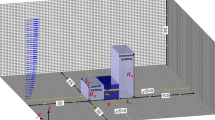Abstract
In this paper, the ventilation performances of (1) isothermal street canyons of different building-height-to-street-width (aspect) ratios (h/b) and (2) a ground-heated street canyon of h/b=1 at different Richardson numbers (Ri) are examined numerically by solving the Reynolds-averaged Navier-Stokes (RANS) equations with the use of the Renormalization Group (RNG) k-ɛ turbulence model. The mean (\( \overline {ACH} \)) and turbulent (ACH’) air exchange rates (ACH) are calculated by the eddy-viscosity model instead of the turbulence kinetic energy (TKE) used elsewhere. For the isothermal street canyons, the ACH’ is found to account for 90% of the total ACH for 0.5 ≤ h/b ≤ 2. Similar to the previous large-eddy simulation (LES) and k-ɛ turbulence model, the magnitudes and shapes of the roof-level profiles of mean and fluctuating vertical winds are close to each other for different h/b. This suggests that turbulent mixing is important for the ventilation of isothermal street canyons. For the ground-heated street canyon, both the mean wind and turbulence are strengthened as illustrated by the increasing \( \overline {ACH} \) and ACH’ with decreasing Ri. A secondary recirculation is developed at the ground-level windward corner that pushes the primary recirculation upward and enhances and ACH as well.
Similar content being viewed by others
References
Baik J-J, Kim J-J (2002). On the escape of pollutants from urban street canyons. Atmospheric Environment, 36: 527–536.
Bentham T, Britter R (2003). Spatially averaged flow within obstacle arrays. Atmospheric Environment, 37: 2037–2043.
Berkowicz R, Plamgrn F, Hertel O, Vignati E (1996). Using measurements of air pollution in street for evaluation of urban air quality-meteorological analysis and model calculations. The Science of the Total Environment, 189: 259–265.
Chan TL, Dong G, Leung CW, Cheung CS, Hung WT (2002). Validation of a two-dimensional pollutant dispersion model in an isolated street canyon. Atmospheric Environment, 36: 861–872.
Croxford B, Penn A (1998). Siting considerations for urban pollution monitors. Atmospheric Environment, 32: 1049–1057.
FLUENT (2008). http://www.fluent.com.
GAMBIT (2008). http://www.fluent.com/software/gambit.
Jeong SJ, Andrews MJ (2002). Application of the k-ɛ turbulence model to the high Reynolds number skimming flow field of an urban street canyon. Atmospheric Environment, 36: 1137–1145.
Kastner-Klein P, Plate EJ (1999). Wind-tunnel study of concentration fields in street canyons. Atmospheric Environment, 33: 3973–3979.
Kastner-Klein P, Fedorovich E, Rotach MW (2001). A wind tunnel study of organised and turbulent air motions in urban street canyons. Journal of Wind Engineering and Industrial Aerodynamics, 89: 849–861.
Kim J-J, Baik J-J (2001). Urban street-canyon flows with bottom heating. Atmospheric Environment, 35: 3395–3404.
Kim J-J, Baik J-J (2003). Effects of inflow turbulence intensity on flow and pollutant dispersion in an urban street canyon. Journal of Wind Engineering and Industrial Aerodynamics, 91: 309–329.
Li X-X, Leung DYC, Liu C-H, Lam KM (2008). Physical modeling of flow field inside urban street canyons. Journal of Applied Meteorology and Climatology, 47: 2058–2067.
Li X-X, Liu C-H, Leung DYC (2005). Development of a k-ɛ model for the determination of air exchange rates for street canyons. Atmospheric Environment, 39: 7285–7296.
Li X-X, Liu C-H, Leung DYC, Lam KM (2006). Recent progress in CFD modeling of wind field and pollutant transport in street canyons. Atmospheric Environment, 40: 5640–5658.
Liu C-H, Leung DYC, Barth MC (2005). On the prediction of air and pollutant exchange rates in street canyons of different aspect ratios using large-eddy simulation. Atmospheric Environment, 39: 1567–1574.
Louka P, Belcher SE, Harrison RG (1998). Modified street canyon flow. Journal of Wind Engineering and Industrial Aerodynamics, 74–76: 485–493.
Louka P, Belcher SE, Harrison RG (2000). Coupling between air flow in streets and the well-developed boundary layer aloft. Atmospheric Environment, 34: 2613–2621.
Meroney RN, Pavageau M, Rafailidis S, Schatzmann M (1996). Study of line source characteristics for 2-D physical modeling of pollutant dispersion in street canyons. Journal of Wind Engineering and Industrial Aerodynamics, 62: 37–56.
Ogawa Y, Diosey PG, Uehara K, Ueda H (1981). A wind tunnel for studying the effects of thermal stratification in the atmosphere. Atmospheric Environment, 15: 807–821.
Oke TR (1988). Street design and urban canopy layer climate. Energy and Building, 11: 103–113.
Sagrado APG, Beeck JV, Rambaud P, Olivari D (2002). Numerical and experimental modelling of pollutant dispersion in a street canyon. Journal of Wind Engineering and Industrial Aerodynamics, 90: 321–339.
Sini J-F, Anquetin S, Mestayer PG (1996). Pollutant dispersion and thermal effects in urban street canyons. Atmospheric Environment, 30: 2659–2677.
Uehara U, Murakami S, Oikawa S, Wakamatsu S (2000). Wind tunnel experiments on how thermal stratification affects flow in and above urban street canyon. Atmospheric Environment, 34: 1553–1562.
Vardoulakis S, Fisher BEA, Pericleous K, Gonzalez-Flesca N (2003). Modelling air quality in street canyons: A review. Atmospheric Environment, 37: 155–182.
Xie X, Huang Z, Wang J-S (2005a). Impact of building configuration on air quality in street canyon. Atmospheric Environment, 39: 4519–4530.
Xie X, Huang Z, Wang J, Xie Z (2005b). The impact of solar radiation and street layout on pollutant dispersion in street canyon. Building and Environment, 40: 201–212.
Xie X, Liu C-H, Leung DYC, Leung MKH (2006). Characteristics of air exchange in a street canyon with ground heating. Atmospheric Environment, 40: 6396–6409.
Yakhot V, Orszag SA, Thangam S, Gatski TB, Speziale CG (1986). Renormalization group analysis of turbulence. Journal on Scientific Computing, 1: 3–51.
Author information
Authors and Affiliations
Corresponding author
Rights and permissions
About this article
Cite this article
Cheng, W.C., Liu, CH. & Leung, D.Y.C. On the comparison of the ventilation performance of street canyons of different aspect ratios and Richardson number. Build. Simul. 2, 53–61 (2009). https://doi.org/10.1007/S12273-008-8332-4
Received:
Revised:
Accepted:
Published:
Issue Date:
DOI: https://doi.org/10.1007/S12273-008-8332-4




